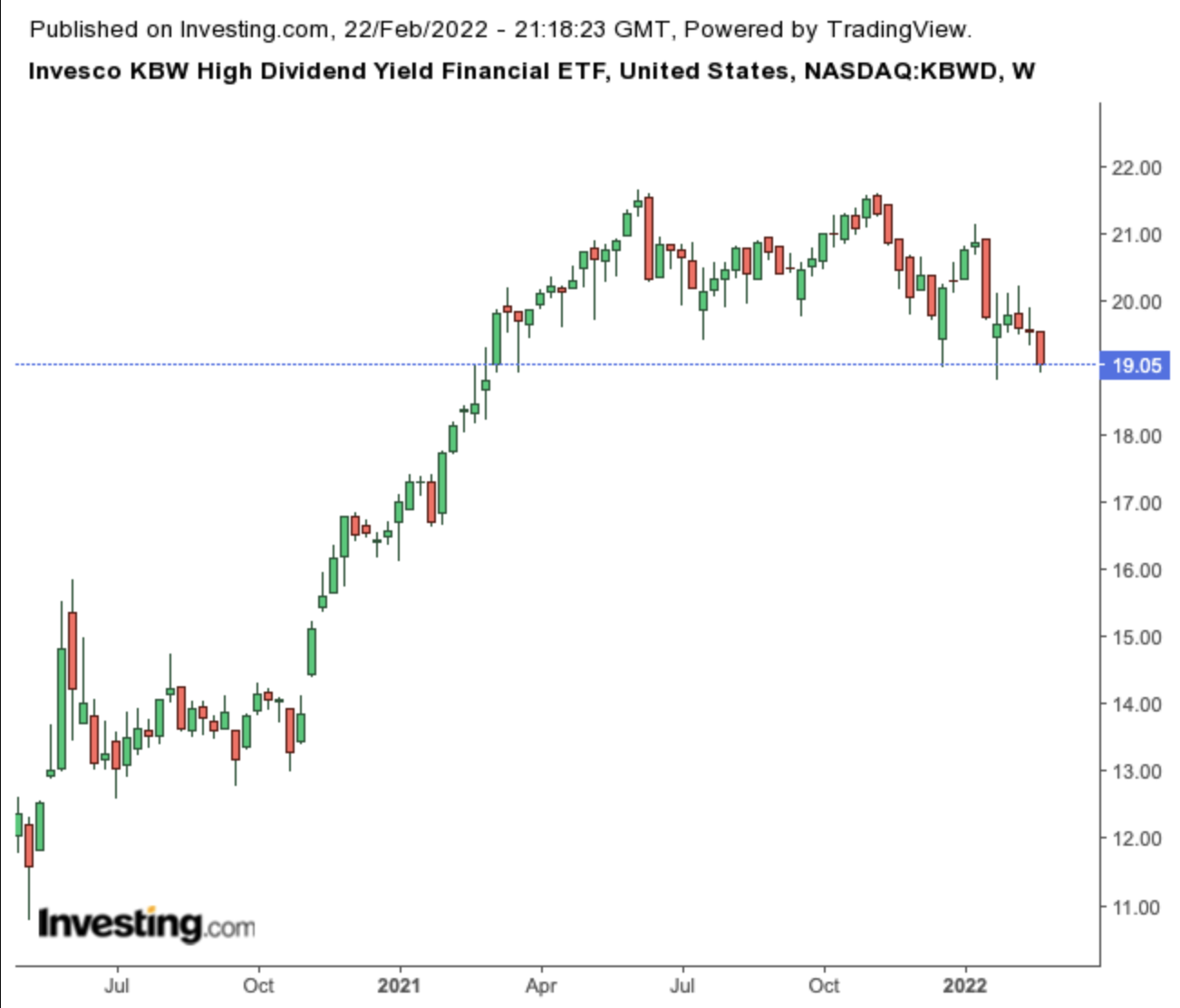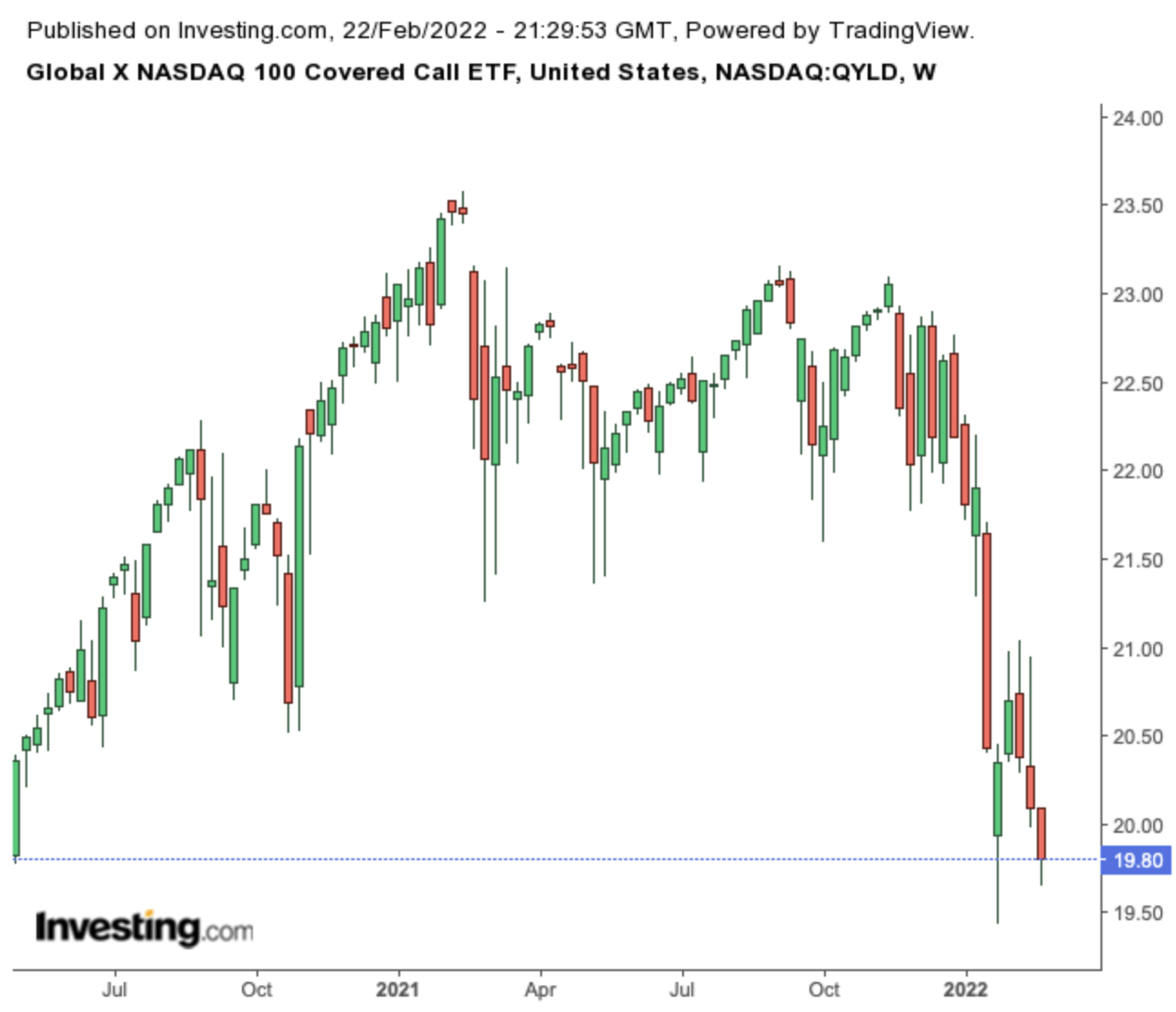On Tuesday, Wall Street started another trading week on a down note, making many investors nervous. After the bull run in 2021, an array of macro catalysts are pushing share prices backward.
So it's no surprise that many investors are hunting for passive income, searching for ways to continue portfolio gains as they increasingly look for yield opportunities in the market.
Therefore, today’s article introduces two exchange-traded funds (ETFs) that could provide long-term portfolios with monthly dividend income streams.
1. Invesco KBW High Dividend Yield Financial ETF
- Current Price: $19.05
- 52-week range: $18.03 - $21.65
- Dividend yield: 7.80%
- Expense ratio: 2.59% per year
Our first fund, the Invesco KBW High Dividend Yield Financial ETF (NASDAQ:KBWD), invests in high-yielding financials stateside. Most of these companies are small- and mid-capitalization (cap) firms. The fund was first listed in December 2010, and its net assets stand at $481.4 million.

KBWD, which has 42 holdings, tracks KBW Nasdaq Financial Sector Dividend Yield Index. The top 10 stocks account for close to 35%, meaning a high concentration.
Among the leading holdings are investment management names Newtek (NASDAQ:NEWT) and FS KKR Capital (NYSE:FSK); specialty finance company Ellington Financial (NYSE:EFC); real estate investment trusts (REITs) ARMOUR Residential (NYSE:ARR) and Ready Capital (NYSE:RC).
In terms of the sub-sectors, we see asset management and custody banks (39.44%), mortgage REITs (36.33%), thrifts and mortgage finance firms (5.18%), and property and casualty insurance (4.70%), among others.
In the past 12 months, the ETF returned 3.76%, and hit a 52-week high in June 2021. Since then, KBWD has lost over 10%. The current price supports a dividend yield of 7.80%. But investors should note the high annual expense ratio.
The fund’s forward Price/Earnings (P/E) and Price/Book (P/B) ratios are 11.93x and 1.46x. However, we should highlight that traditional valuation metrics are not fully helpful in evaluating financial sector funds (or stocks), especially when we have private equity names, REITs, and mortgage REIT, which use leverage. Therefore, further due diligence is needed.
KBWD deserves income seekers’ attention in these uncertain times when yields are not easy to find. However, the fund comes with a high expense ratio. And the fact that most holdings are small-caps could increase the volatility of returns in the short run. Investors should be aware of both the benefits and drawbacks of an ETF like KBWD.
2. Global X NASDAQ 100 Covered Call ETF
- Current Price: $19.80
- 52-Week Range: $19.43 - $23.58
- Distribution Yield: 13.04%
- Expense Ratio: 0.60% per year
Investors are increasingly paying attention to covered call ETFs in the search for higher yields. Regular readers of this column would know that we have previously provided examples of covered calls (for instance, here and here).

The Global X NASDAQ 100 Covered Call ETF (NASDAQ:QYLD) creates yield through a covered call or “buy-write” strategy. The fund first buys shares of companies in the NASDAQ 100. Then, QYLD “writes” (or sells) monthly at-the-money index call options. Thus, the ETF generates income through covered call writing.
Readers well-versed in options would know that options premiums typically increase when volatility goes up, leading to higher income levels for a fund like QYLD.
We should also note that QYLD sells index options and not single stock options. Index options cannot be exercised (or called) early. Therefore, the most important price level for QYLD is where the index ends at the expiry time. All other intra-month price moves are irrelevant for returns.
Since its inception at the end of 2013, net assets in the fund have reached $6.34 billion.
Since the start of the year, the NASDAQ 100 index and Invesco QQQ Trust (NASDAQ:QQQ), which tracks the tech-heavy index, have been down around 15%. However, QYLD, which buys the same securities as the QQQ fund but then writes call options on the index, is down 10.7%.
The fund makes payments monthly. Meanwhile, the 12-month trailing yield is 14.46%. An investor in QYLD would have received this yield if the fund had been held over that period.
However, interested readers should note covered calls cap (or limit) QYLD’s gains in a rising market. For instance, although the NASDAQ 100 index has gone up about 2.1% over the last 12 months, QYLD decreased by 15.5%. However, QYLD’s current yield is 12.9%.
Although the fund’s risk/return profile will not suit all readers, it might appeal to those looking for regular monthly yields from tech shares.
